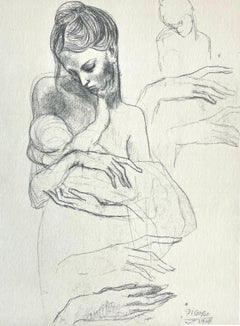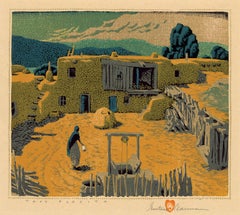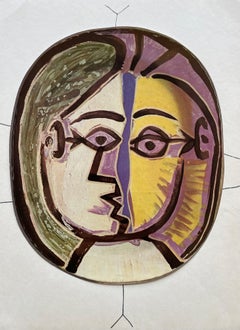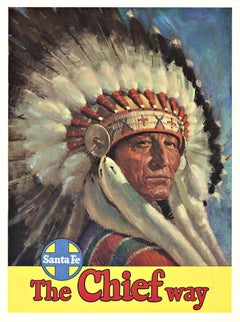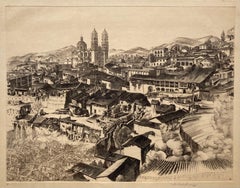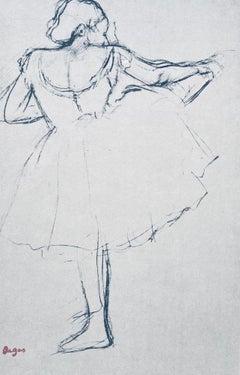1940s Landscape Prints
to
531
504
91
35
19
9
Overall Width
to
Overall Height
to
219
137
95
9
5
5
2
1
1
13
11
7
7
6
981
2,042
10,477
4,099
113
169
689
528
660
1,293
1,831
1,788
1,150
556
638
426
230
2
486
319
292
159
154
128
81
63
56
45
34
30
28
26
26
24
23
23
19
18
442
84
77
28
21
22
45
595
53
Period: 1940s
Picasso, Mother and Child (Orozco 95), Picasso (after)
Located in Fairfield, CT
Medium: Lithograph and stencil on vélin paper
Year: 1946
Paper Size: 18.75 x 12.625 inches
Inscription: Signed in the plate and unnumbered, as issued
Catalogue raisonné reference: Or...
Category
Cubist 1940s Landscape Prints
Materials
Lithograph
$3,996 Sale Price
20% Off
'Taos Placita' — American Southwest Regionalist Masterwork
Located in Myrtle Beach, SC
Gustave Baumann, 'Taos Placita', color woodcut, 1947, edition 125. Baumann 132. Signed, titled, and numbered '20-125' in pencil; with the artist’s Hand-in-Heart chop. A superb, richly-inked impression, with fresh colors, on fibrous oatmeal wove paper; the full sheet with margins (2 to 3 1/8 inches); slight rippling at the left sheet edge, in excellent condition. Matted to museum standards, unframed.
Image size 9 5/8 x 11 1/4 inches (244 x 286 mm); sheet size 13 1/4 x 17 inches (337 x 432 mm).
Collections: New Mexico Museum of Art, Phoenix Art Museum, Wichita Art Museum.
ABOUT THE ARTIST
Gustave Baumann (1881-1971) was a renowned printmaker and a leading figure of the American color woodcut revival whose exquisite craftsmanship and vibrant imagery captured the essence of the Southwest.
"A brilliant printmaker, Baumann brought to the medium a full mastery of the craft of woodworking that he acquired from his father, a German cabinetmaker. This craftsmanship was coupled with a strong artistic training that resulted in the handsome objects we see in the exhibition today. After discovering New Mexico in 1918, Baumann began to explore in his woodblock prints of this period the light. color, and architectural forms of that landscape. His prints of this period are among the most beautiful and poetic images of the American West."
—Lewis I. Sharp, Director, Denver Art Museum
Baumann, the son of a craftsman, immigrated to the United States from Germany with his family when he was ten, settling in Chicago. From 1897 to 1904, he studied in the evenings at the Art Institute of Chicago, working in a commercial printmaking shop during the day. In 1905, he returned to Germany to attend the Kunstwerbe Schule in Munich, where he decided on a career in printmaking. He returned to Chicago in 1906 and worked for a few years as a graphic designer of labels.
Baumann made his first prints in 1909 and exhibited them at the Art Institute of Chicago the following year. In 1910, he moved to the artists’ colony in Nashville, Indiana, where he explored the creative and commercial possibilities of a career as a printmaker. In 1915, he exhibited his color woodcuts at the Panama-Pacific International Exposition in San Francisco, winning the gold medal.
Among Baumann’s ongoing commercial activities was his work for the Packard Motor Car Company from 1914 to 1920 where he produced designs, illustrations, and color woodcuts until 1923.
In 1919, Baumann’s printmaking work dominated the important exhibition of American color woodcuts at the Detroit Institute of Arts. Twenty-six of his prints were included, far more than the works of any other artist. A set of his blocks, a preparatory drawing, and seven progressive proofs complemented the exhibition. That same year, Baumann worked in New York and, over the summer, in Provincetown, Massachusetts. His airy images of Cape Cod employed soft, pastel colors and occasionally showed the influence of the white-line woodcut technique.
Many of his Chicago artist friends had traveled to the southwest, and Baumann became intrigued by their paintings, souvenirs, and stories of an exotic place named Taos, New Mexico. In the summer of 1918, he spent the summer in Taos sketching and painting before visiting Santa Fe. Paul Walter, the director of the Museum of New Mexico, offered him a studio in the museum's basement. Inspired by the rugged beauty of the Southwest—the vibrant colors and dramatic landscapes of the region became a central theme in his work, influencing his artistic style and subject matter for the remainder of his career. Later in the decade, he traveled to the West Coast and made prints of California landscape.
Baumann's prints became synonymous with the Southwest, capturing the spirit of its place in America's identity with a unique sense of authenticity and reverence. His iconic images of desert vistas, pueblo villages, and indigenous cultures served as visual tributes to the region's rich cultural heritage, earning him a dedicated following among collectors and curators alike.
A true craftsman and artist, Baumann completed every step of the printmaking process himself, cutting each block, mixing the inks, and printing every impression on the handmade paper he selected. His dedication to true craftsmanship and his commitment to preserving the integrity of his artistic vision earned him widespread acclaim and recognition within the art world. About the vibrant colors he produced, Baumann stated, “A knowledge of color needs to be acquired since they don’t all behave the same way when ground or mixed...careful chemistry goes into the making of colors, with meticulous testing for permanence. While complicated formulae evolve new colors, those derived from Earth and metal bases are still the most reliable.”
In the 1930s, Baumann became interested in puppet theater. He designed and carved his own marionettes and established a little traveling company. From 1943 to 1945, the artist carved an altarpiece for the Episcopal Church of the Holy Faith in Santa Fe. In 1952, a retrospective exhibition of his prints was mounted at the New Mexico Museum of Fine Arts. Throughout his prolific career, Baumann executed nearly four hundred color woodcuts.
Baumann’s woodcuts...
Category
American Modern 1940s Landscape Prints
Materials
Woodcut
Picasso, étude pour la céramique, Céramiques de Picasso (Orozco 105) (after)
Located in Fairfield, CT
Medium: Collotype and lithograph on vélin gloss finish paper (to resemble the finish of ceramic), archivally hinged on vélin paper
Year: 1948
Paper Size: 15 x 11.25 inches
Catalogue ...
Category
Cubist 1940s Landscape Prints
Materials
Lithograph
$1,436 Sale Price
20% Off
Santa Fe The Chief Way original American railroad poster
Located in Spokane, WA
Original Santa Fe The Chief Way vintage railroad travel poster. Archival linen backed in very fine condition, ready to frame. Most of the Santa Fe Railway posters feature American Indians, but this poster features the big boss, The Chief! The poster has about a 1" white border around the entire image, the linen backing is not counted in the poster's measurement.
Several of the trains were named "Chief" which includes the San Francisco Chief, Texan Chief, Kansas City Chief...
Category
American Impressionist 1940s Landscape Prints
Materials
Offset
$759 Sale Price
20% Off
LIGHT AND SHADE TAXCO - J. T. Arms Mexican Masterpiece with Striking Detail
Located in Santa Monica, CA
JOHN TAYLOR ARMS (1887 – 1953)
LIGHT AND SHADE TAXCO, 1946 (F. 394: (#2 from the Mexican series.)
Etching and aquatint signed and dated in pencil. Image 10 ½ x 13 5/8, sheet 14 1/...
Category
American Realist 1940s Landscape Prints
Materials
Etching
Degas, Dancer at the bar, Ten Ballet Sketches (after)
By Edgar Degas
Located in Fairfield, CT
Medium: Lithograph and stencil on vélin paper
Year: 1945
Paper Size: 17 x 13 inches
Inscription: Signed in the plate and unnumbered, as issued
Notes: From the folio, Degas, Ten Balle...
Category
Impressionist 1940s Landscape Prints
Materials
Lithograph
$716 Sale Price
20% Off
Japanese Pagoda Woodblock Landscape
Located in Douglas Manor, NY
3722 Japanese Woodblock on paper set in a vintage wood frame
Image size 9x10.5"
Category
1940s Landscape Prints
Materials
Ink
$340 Sale Price
20% Off
Composition (Cramer 36; Bloch 360; Horodisch A6), Non Vouloir, Pablo Picasso
Located in Auburn Hills, MI
Zincograph on Vélin Bouffant paper. Unsigned and unnumbered, as issued. Good condition. Notes: From the volume, Non Vouloir, 1942. Published by Éditions Jeanne Bucher, Paris; printed...
Category
Cubist 1940s Landscape Prints
Materials
Etching
$1,596 Sale Price
20% Off
Rodin, Composition, La Varende, Rodin (after)
Located in Auburn Hills, MI
Lithograph and stencil on vélin pur fil paper. Inscription: unsigned and unnumbered, as issued. Good condition. Notes: From the folio, La Varende, Rodin, 1944. Published by Éditions ...
Category
Modern 1940s Landscape Prints
Materials
Lithograph, Stencil
$716 Sale Price
20% Off
Léger, Composition, Cahiers d'Art (after)
Located in Auburn Hills, MI
Lithograph and stencil on vélin paper. Unsigned and unnumbered, as issued. Good condition. Notes: From the album, Cahiers d'Art N°24, 1949. Published and printed by Éditions des Cahi...
Category
Modern 1940s Landscape Prints
Materials
Lithograph
$716 Sale Price
20% Off
Composition (Duthuit N° 17), Pierre à feu, Les Miroirs profonds, Henri Matisse
Located in Auburn Hills, MI
Lithograph in five colors on vélin supérieur paper. Unsigned and unnumbered, as issued. Good condition. Published by Maeght, éditeur, Paris; printed by Mourlot Frères, Paris, January...
Category
Modern 1940s Landscape Prints
Materials
Lithograph
SLOW TRAIN THROUGH ARKANSAS
Located in Portland, ME
Benton, Thomas Hart (American, 1889-1975 SLOW TRAIN THROUGH ARKANSAS. Fath . Lithograph, 1941. Edition of 250 published by Associated American Artists (A.A.A.). 9 7/8 x 12 inches (im...
Category
1940s Landscape Prints
Materials
Lithograph
Degas, La Danseuse de dos, E. Degas Monotypes (after)
By Edgar Degas
Located in Fairfield, CT
Medium: Engraving on vélin du Marais paper
Year: 1948
Paper Size: 12.25 x 9.125 inches; image size: 8.5 x 6.75 inches
Inscription: Unsigned and unnumbered, as issued
Notes: From the ...
Category
Impressionist 1940s Landscape Prints
Materials
Engraving
$1,996 Sale Price
20% Off
Bonnard, Composition (Terrasse 54), Pierre Bonnard Correspondences (after)
Located in Auburn Hills, MI
Lithograph on vélin d’Arches paper, mounted on vélin d’Arches backing sheet, as issued. Inscription: Unsigned and unnumbered, as issued. Good condition. Notes: From the album, Corres...
Category
Modern 1940s Landscape Prints
Materials
Lithograph
$716 Sale Price
44% Off
Original 1945 Paris (France) vintage travel poster travel by train
By Paul Colin
Located in Spokane, WA
Original PARIS linen-backed 1946 vintage travel poster, preservation linen-backed and ready to frame. Very good condition, Grade A-
Original 1946 Paul Colin Paris Vintage Poster ...
Category
American Modern 1940s Landscape Prints
Materials
Lithograph
Picasso, Study for Les Demoiselles D'Avignon (Orozco 95), Picasso (after)
Located in Fairfield, CT
Medium: Lithograph and stencil on vélin paper
Year: 1946
Paper Size: 18.75 x 12.625 inches
Inscription: Signed in the plate and unnumbered, as issued
Catalogue raisonné reference: Or...
Category
Cubist 1940s Landscape Prints
Materials
Lithograph
$3,996 Sale Price
20% Off
Picasso, Composition, Carnet de dessins de Picasso, Cahiers d’Art (after)
Located in Fairfield, CT
Medium: Lithograph on vélin paper
Year: 1948
Paper Size: 16.54 x 11.81 inches
Inscription: Inscription: Unsigned and unnumbered, as issued
Notes: From the album, Carnet de dessins de...
Category
Cubist 1940s Landscape Prints
Materials
Lithograph
$2,796 Sale Price
20% Off
Degas, Sketch of Dancers, Ten Ballet Sketches (after)
By Edgar Degas
Located in Fairfield, CT
Medium: Lithograph and stencil on vélin paper
Year: 1945
Paper Size: 13 x 17 inches
Inscription: Unsigned and unnumbered, as issued
Notes: From the folio, Degas, Ten Ballet Sketches,...
Category
Impressionist 1940s Landscape Prints
Materials
Lithograph
$716 Sale Price
20% Off
'Landscape', Kansas City Art Institute, New York, Art Students League, WPA, WWAA
Located in Santa Cruz, CA
Signed lower right, outside of design, 'Guy Maccoy' (American, 1904-1981), dated 1942 and titled, lower left, 'Gray Landscape'. Additionally stamped, verso,...
Category
1940s Landscape Prints
Materials
Paint, Paper
Degas, Three Dancers, Ten Ballet Sketches (after)
By Edgar Degas
Located in Fairfield, CT
Medium: Lithograph and stencil on vélin paper
Year: 1945
Paper Size: 13 x 17 inches
Inscription: Signed in the plate and unnumbered, as issued
Notes: From the folio, Degas, Ten Balle...
Category
Impressionist 1940s Landscape Prints
Materials
Lithograph
$716 Sale Price
20% Off
Nebraska Evening
Located in London, GB
A fine impression with good margins published by Associated American Artists.
Category
American Modern 1940s Landscape Prints
Materials
Lithograph
Original Paris 1900 de la Belle Epoque 1900-1914 vintage French movie poster
Located in Spokane, WA
Original 1947 Paris 1900 lithographic movie poster by the artist Raymond Peynet. The poster had originally been folded, and there is some wrinkling at the bottom edge of the poste...
Category
Art Nouveau 1940s Landscape Prints
Materials
Lithograph
Vuillard, La Naissance d´Annette, L'œuvre gravé de Vuillard (after)
Located in Fairfield, CT
Medium: Lithograph on grand vélin Renage paper
Year: 1948
Paper Size: 12.5 x 19.25 inches; image size: 11.42 x 16.54 inches, with centerfold, as issued
Inscription: Unsigned and unnu...
Category
Post-Impressionist 1940s Landscape Prints
Materials
Lithograph
$716 Sale Price
20% Off
Merano La Conca d"oro dell'Alto Adige original vintage lithograph poster
Located in Spokane, WA
Artist: Franz Lenhart. Size: 27.5" x 39". Professional archival linen backed; ready to frame. "La Conca d'Oro dell 'alto Adige"
The water flows f...
Category
Naturalistic 1940s Landscape Prints
Materials
Lithograph
Degas, Dancer at the bar, Ten Ballet Sketches (after)
By Edgar Degas
Located in Fairfield, CT
Medium: Lithograph and stencil on vélin paper
Year: 1945
Paper Size: 13 x 17 inches
Inscription: Signed in the plate and unnumbered, as issued
Notes: From the folio, Degas, Ten Balle...
Category
Impressionist 1940s Landscape Prints
Materials
Lithograph
$716 Sale Price
20% Off
Grant Wood Original Pencil Signed Lithograph, 1940 - February
By Grant Wood
Located in Phoenix, AZ
Original pencil signed Grant Wood lithograph, "February," created 1940.
A fine impression and one of the most important of the 19 lithographs created by the painter of "American Goth...
Category
1940s Landscape Prints
Materials
Paper, Lithograph
Original 1948 American Airlines - California Arizona Texas New Mexico
Located in Spokane, WA
Original American Airlines - California, Arizona, Texas, New Mexico by McKnight Kauffer, 1948 vintage poster. Archival linen backed in Grade A, Excellent condition. No paper loss and no restoration.
Kauffer’s signature artistry is on full display with a bold and minimalist design. The striking depiction of a Western figure adorned with a cowboy hat and scarf emphasizes California, Arizona, Texas, and New Mexico—the sun-drenched landscapes and destinations of the era's most adventurous travelers. The clean typography and bold color contrasts evoke modernism and nostalgia, making the piece a perfect centerpiece for collectors of aviation history, vintage travel memorabilia, or timeless graphic art.
Designed by E. McKnight Kauffer, a renowned artist known for his bold use of color and striking designs, this poster is a masterpiece that resonates with the charm of a bygone era. This original piece from 1948 tells a story about American Airlines and reflects the excitement of post-war travel and the booming airline industry. This rare, authentic poster...
Category
American Modern 1940s Landscape Prints
Materials
Lithograph
Harry Shokler, Island Harbor
Located in New York, NY
Harry Shokler used serigraphy to great advantage in this landscape. It's colorful and detailed.
It is signed in the image at the lower left. When printmakers began making serigraphs...
Category
American Modern 1940s Landscape Prints
Materials
Screen
Composition (Duthuit N° 17), Pierre à feu, Les Miroirs profonds, Henri Matisse
Located in Auburn Hills, MI
Lithograph on vélin supérieur paper. Unsigned and unnumbered, as issued. Good condition. Published by Maeght, éditeur, Paris; printed by Mourlot Frères, Paris, January 17, 1947. Note...
Category
Modern 1940s Landscape Prints
Materials
Lithograph
Ruine, Surrealist Lithograph by André Masson
By André Masson
Located in Long Island City, NY
André Masson, French (1896 -1987) - Ruine, Year: 1945, Medium: Lithograph, signed and numbered in pencil, Edition: 10/30, Image Size: 8 x 6.25 inches, Size: 14 x 11 in. (35.56 x...
Category
Surrealist 1940s Landscape Prints
Materials
Lithograph
Original Loterie Nationale Tranche de L'Histoire de France vintage poster
Located in Spokane, WA
Original 1940 Loterie Nationale Vintage Poster. Tranche de l”Historie de France. Linen-backed in very good condition – excellent, ready to frame. The team of Eddgard Derouet and C...
Category
Art Deco 1940s Landscape Prints
Materials
Lithograph
'The East River', Brooklyn Bridge — Mid-Century Realism, New York City
Located in Myrtle Beach, SC
Lawrence Nelson Wilbur (1897-1988), 'The East River', drypoint, edition 65, 1946. Signed, titled, and annotated 'A. Jones Proof 1946' in pencil. Signed and dated in the plate, lower ...
Category
American Modern 1940s Landscape Prints
Materials
Drypoint
Degas, Dancer arranging her dress, Ten Ballet Sketches (after)
By Edgar Degas
Located in Fairfield, CT
Medium: Lithograph and stencil on vélin paper
Year: 1945
Paper Size: 17 x 13 inches
Inscription: Signed in the plate and unnumbered, as issued
Notes: From the folio, Degas, Ten Balle...
Category
Impressionist 1940s Landscape Prints
Materials
Lithograph
$716 Sale Price
20% Off
Degas, Le Bain, E. Degas Monotypes (after)
By Edgar Degas
Located in Fairfield, CT
Medium: Engraving on vélin du Marais paper
Year: 1948
Paper Size: 9.125 x 12.25 inches; image size: 4.5 x 9 inches
Inscription: Unsigned and unnumbered, as issued
Notes: From the vol...
Category
Impressionist 1940s Landscape Prints
Materials
Engraving
$716 Sale Price
20% Off
Picasso, étude pour la céramique, Céramiques de Picasso (Orozco 105) (after)
Located in Fairfield, CT
Medium: Collotype and lithograph on vélin gloss finish paper (to resemble the finish of ceramic), archivally hinged on vélin paper
Year: 1948
Paper Size: 11.25 x 15 inches
Catalogue ...
Category
Cubist 1940s Landscape Prints
Materials
Lithograph
$1,436 Sale Price
20% Off
Picasso, Composition, Carnet de dessins de Picasso, Cahiers d’Art (after)
Located in Fairfield, CT
Medium: Lithograph on vélin paper
Year: 1948
Paper Size: 16.54 x 11.81 inches
Inscription: Inscription: Unsigned and unnumbered, as issued
Notes: From the album, Carnet de dessins de...
Category
Cubist 1940s Landscape Prints
Materials
Lithograph
$2,796 Sale Price
20% Off
Vuillard, Les deux belles-soeurs, L'œuvre gravé de Vuillard (after)
Located in Fairfield, CT
Medium: Lithograph on grand vélin Renage paper
Year: 1948
Paper Size: 12.375 x 9.5 inches; image size: 11.81 x 9.05 inches
Inscription: Unsigned and unnumbered, as issued
Notes: From...
Category
Post-Impressionist 1940s Landscape Prints
Materials
Lithograph
$716 Sale Price
20% Off
Degas, Dancer touching her earring, Ten Ballet Sketches (after)
By Edgar Degas
Located in Fairfield, CT
Medium: Lithograph and stencil on vélin paper
Year: 1945
Paper Size: 17 x 13 inches
Inscription: Signed in the plate and unnumbered, as issued
Notes: From the folio, Degas, Ten Balle...
Category
Impressionist 1940s Landscape Prints
Materials
Lithograph
$716 Sale Price
20% Off
WESTERN GRANDEUR
Located in Santa Monica, CA
HAROLD LUKENS DOOLTTLE (1883 - 1974)
WESTERN GRANDEUR c. 1945
Aquatint, signed titled and dedicated. Image 9 ¾ x 13 5/8 inches. Large full sheet with deckle edges 15 ½ x 19 inches...
Category
American Realist 1940s Landscape Prints
Materials
Aquatint
Degas, Seated dancer, removing her slipper, Ten Ballet Sketches (after)
By Edgar Degas
Located in Fairfield, CT
Medium: Lithograph and stencil on vélin paper
Year: 1945
Paper Size: 17 x 13 inches
Inscription: Signed in the plate and unnumbered, as issued
Notes: From the folio, Degas, Ten Balle...
Category
Impressionist 1940s Landscape Prints
Materials
Lithograph
$716 Sale Price
20% Off
Composition, Alternance, Jean Cocteau
By Jean Cocteau
Located in Auburn Hills, MI
Etching on Rives BFK paper. Unsigned and unnumbered, as issued. Good condition. Notes: From the folio, Alternance, 1946. Published by Le Gerbier, Paris; printed by atelier Quesnevill...
Category
Modern 1940s Landscape Prints
Materials
Engraving
$1,436 Sale Price
20% Off
Rodin, Composition, La Varende, Rodin (after)
Located in Auburn Hills, MI
Lithograph and stencil on vélin pur fil paper. Inscription: unsigned and unnumbered, as issued. Good condition. Notes: From the folio, La Varende, Rodin, 1944. Published by Éditions ...
Category
Modern 1940s Landscape Prints
Materials
Lithograph, Stencil
$716 Sale Price
20% Off
Original You buy 'em We'll fly 'em! Defense Bonds vintage WW2 poster
Located in Spokane, WA
Original vintage poster: "You buy 'em We'll fly 'em!" Artists: J. Walter Wilkinson and his son Walter G. Wilkinson. (1917 - 1971). Linen backed with original WW2 U.S. military with original issued fold marks restored. Excellent condition. Touchup pinhole in the four corners. Excellent colors. Ready to frame.
A flying ace pilot smiles and gives the thumbs up to the viewer to promote war bonds, saying, "You Buy 'Em, We'll Fly' Em" in this 1942 WWII poster by J. Walter Wilkinson and his son Walter G. Wilkinson. The artwork features a squadron of Douglas SBD Dauntless, which the US Navy used as scout planes and dive bombers. The seal at the bottom of the poster reads, "The More Bonds You Buy- The More Planes Will Fly." This poster is one in a series of six created by the award-winning father-son team for the United States Treasury Department. J. Walter Wilkinson (1892-1988) and his son Walter G. Wilkinson (1917-1971) created several posters for the United States Department of Treasury during the Second World War. J. Walter Wilkinson was an academic painter who studied in Italy and worked for advertising agencies in Philadelphia. He specialized in outdoor landscapes and created many commercial artworks for advertising campaigns, including Ivory Soap, Pabst Beer...
Category
American Modern 1940s Landscape Prints
Materials
Offset
Picasso, étude pour la céramique, Céramiques de Picasso (Orozco 105) (after)
Located in Fairfield, CT
Medium: Collotype and lithograph on vélin gloss finish paper (to resemble the finish of ceramic), archivally hinged on vélin paper
Year: 1948
Paper Size: 11.25 x 15 inches
Catalogue ...
Category
Cubist 1940s Landscape Prints
Materials
Lithograph
$1,436 Sale Price
20% Off
Vuillard, Intérieur aux tentures roses, L'œuvre gravé de Vuillard (after)
Located in Fairfield, CT
Medium: Lithograph on grand vélin Renage paper
Year: 1948
Paper Size: 12.375 x 9.5 inches; image size: 11.81 x 9.05 inches
Inscription: Unsigned and unnumbered, as issued
Notes: From...
Category
Post-Impressionist 1940s Landscape Prints
Materials
Lithograph
$716 Sale Price
20% Off
Seurat, L'homme au plaid, Seurat (after)
Located in Fairfield, CT
Medium: Lithograph on vélin du Canson & Montgolfier Vidalon-Les-Annonay paper
Year: 1948
Paper Size: 12.5 x 9.75 inches
Inscription: Unsigned and unnumbered, as issued
Notes: From th...
Category
Post-Impressionist 1940s Landscape Prints
Materials
Lithograph
$876 Sale Price
20% Off
Mediterranean Landscape - Original Lithograph - Handsigned
Located in Paris, IDF
Charles CAMOIN
Mediterranean Landscape, 1946
Original lithograph
Signed in pencil bottom right
Numbered / XX
On Lana vellum 26 x 36 cm (c. 10...
Category
Post-Impressionist 1940s Landscape Prints
Materials
Lithograph
Renoir, Nu, Seize Aquarelles et Sanguines de Renoir (after)
Located in Fairfield, CT
Medium: Lithograph and stencil on vélin d’Arches Johannot paper
Year: 1948
Paper Size: 15 x 10.75 inches
Inscription: Unsigned and unnumbered, as issued
Notes: From the folio, Seize ...
Category
Impressionist 1940s Landscape Prints
Materials
Lithograph
$1,436 Sale Price
20% Off
Toulouse-Lautrec, Composition, Images de Lautrec (after)
Located in Fairfield, CT
Medium: Lithograph and stencil on vélin Polifilo paper
Year: 1947
Paper Size: 13.78 x 10.24 inches
Inscription: Signed in the plate and unnumbered, as issued
Notes: From the folio, I...
Category
Post-Impressionist 1940s Landscape Prints
Materials
Lithograph
$716 Sale Price
20% Off
Renoir, Marine, Seize Aquarelles et Sanguines de Renoir (after)
Located in Fairfield, CT
Medium: Lithograph and stencil on vélin d’Arches Johannot paper
Year: 1948
Paper Size: 15 x 10.75 inches
Inscription: Unsigned and unnumbered, as issued
Notes: From the folio, Seize ...
Category
Impressionist 1940s Landscape Prints
Materials
Lithograph
$1,436 Sale Price
20% Off
'Sundown, Stonington, Maine' — Artist-printed Exhibition Proof
Located in Myrtle Beach, SC
Lawrence Nelson Wilbur (1897-1988), 'Sundown, Stonington, Maine', wood engraving, artist's proof, edition not stated but small, 1969. Signed and titled in pencil. Signed in the block...
Category
American Modern 1940s Landscape Prints
Materials
Woodcut
Kawase Hasui -- Snow at Hie Shrine, circa 1946 - 1957
By Kawase Hasui
Located in BRUCE, ACT
Kawase Hasui (Japanese, 1883-1957)
Snow at Hie Shrine, circa 1946 -1957 (dated in the publisher's seal)
Woodblock
Sheet size 37.5 x 26.0 cm (vertical oban)
Frame size 51.3 x 38.5 x 2...
Category
1940s Landscape Prints
Materials
Woodcut
$5,512 Sale Price
20% Off
Degas, La Chanteuse du Cafe-Concert, E. Degas Monotypes (after)
By Edgar Degas
Located in Fairfield, CT
Medium: Engraving on vélin du Marais paper
Year: 1948
Paper Size: 12.25 x 9.125 inches; image size: 6.5 x 5 inches
Inscription: Unsigned and unnumbered, as issued
Notes: From the vol...
Category
Impressionist 1940s Landscape Prints
Materials
Engraving
$796 Sale Price
20% Off
Picasso, étude pour la céramique, Céramiques de Picasso (Orozco 105) (after)
Located in Fairfield, CT
Medium: Collotype and lithograph on vélin gloss finish paper (to resemble the finish of ceramic), archivally hinged on vélin paper
Year: 1948
Paper Size: 11.25 x 15 inches
Catalogue ...
Category
Cubist 1940s Landscape Prints
Materials
Lithograph
$1,436 Sale Price
20% Off
Degas, Melina Darde, Ten Ballet Sketches (after)
By Edgar Degas
Located in Fairfield, CT
Medium: Lithograph and stencil on vélin paper
Year: 1945
Paper Size: 17 x 13 inches
Inscription: Signed in the plate and unnumbered, as issued
Notes: From the folio, Degas, Ten Balle...
Category
Impressionist 1940s Landscape Prints
Materials
Lithograph
$716 Sale Price
20% Off
Vuillard, Intérieur a la suspension, L'œuvre gravé de Vuillard (after)
Located in Fairfield, CT
Medium: Lithograph on grand vélin Renage paper
Year: 1948
Paper Size: 12.375 x 9.5 inches; image size: 12.2 x 9.45 inches
Inscription: Unsigned and unnumbered, as issued
Notes: From ...
Category
Post-Impressionist 1940s Landscape Prints
Materials
Lithograph
$716 Sale Price
20% Off
Renoir, Paysage, Seize Aquarelles et Sanguines de Renoir (after)
Located in Fairfield, CT
Medium: Lithograph and stencil on vélin d’Arches Johannot paper
Year: 1948
Paper Size: 10.75 x 15 inches
Inscription: Unsigned and unnumbered, as issued
Notes: From the folio, Seize ...
Category
Impressionist 1940s Landscape Prints
Materials
Lithograph
$1,436 Sale Price
20% Off
Picasso, étude pour la céramique, Céramiques de Picasso (Orozco 105) (after)
Located in Fairfield, CT
Medium: Collotype and lithograph on vélin gloss finish paper (to resemble the finish of ceramic), archivally hinged on vélin paper
Year: 1948
Paper Size: 11.25 x 15 inches
Catalogue ...
Category
Cubist 1940s Landscape Prints
Materials
Lithograph
$1,436 Sale Price
20% Off
Miró, Composition, Cahiers d'Art (after)
By Joan Miró
Located in Auburn Hills, MI
Lithograph and stencil on vélin paper. Unsigned and unnumbered, as issued. Good condition. Notes: From the album, Cahiers d'Art N°24, 1949. Published and printed by Éditions des Cahi...
Category
Modern 1940s Landscape Prints
Materials
Lithograph
Toulouse-Lautrec, Composition, Henri de Toulouse-Lautrec, Dessinateur (after)
Located in Auburn Hills, MI
Lithograph on vélin paper. Paper size: 12.25 x 9.25 inches. Inscription: Signed in the plate and unnumbered, as issued. Notes: From the album, Henri de Toulouse-Lautrec, Dessinateur,...
Category
Post-Impressionist 1940s Landscape Prints
Materials
Lithograph
$716 Sale Price
20% Off
